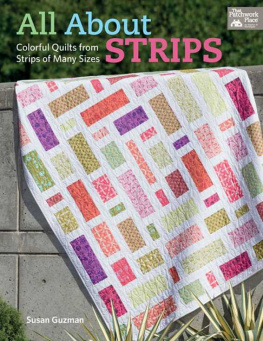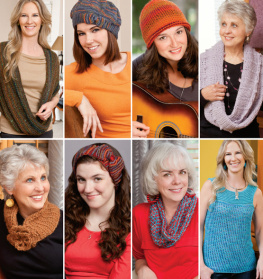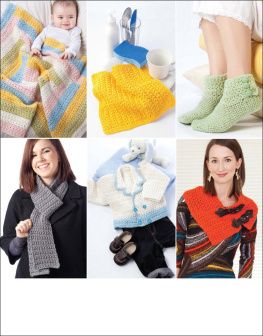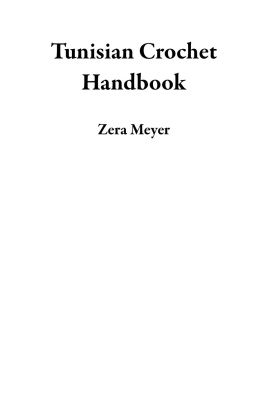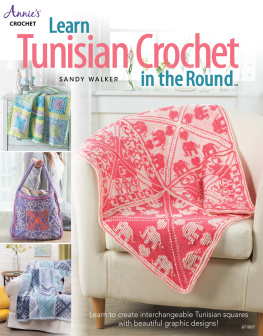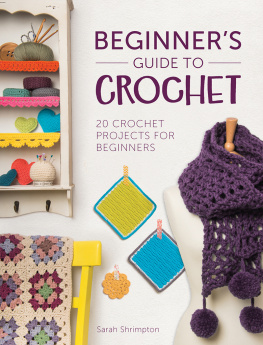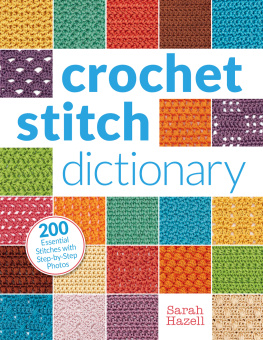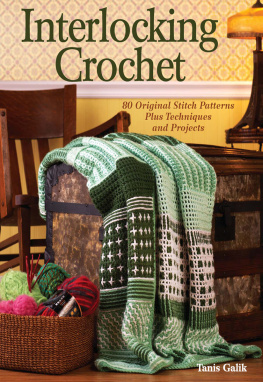ULTIMATE BEGINNERS GUIDE TO
TUNISIAN
CROCHET
These fashions are elegant, with the fine texture and appearance of knitwearbut theyre not knitted! Theyre made with Tunisian crochet. Award-winning teacher Kim Guzman presents nine fresh designs for you to explore. Learn the skills you need to make a scarf and advance through a hat, ruana, cowl, crib cover, duffel bag, and more. Kim walks you through the basics and takes you through each step with clear photos and friendly instructions.
If you like the ease of working with a crochet hook, but admire the look and feel of knitted fabric, youll love learning Tunisian crochet.
LEISURE ARTS, INC.
Little Rocks, Arkansas
KIM GUZMAN fills each day with creativity. Whether shes knitting or crocheting a new design or working on a new canning experiment with the fruit and vegetables she grows at her home in Arkansas, she fulfills a lifelong dreamendless creative ventures in a lovely country setting with her family close at hand. Her mother likes to call Kim the garden paparazzi when she rushes out to take photos of flowers, fruit, vegetables, and beautiful butterflies.
The design work that helps Kim realize this dream has won several awards, including eight Flamies from the Crochet Liberation Front. One of these was the 2011 award for Best Teacher. Kim has authored several pattern books, and her designs have appeared in yarn craft magazines.
Kim says, My goal is to produce crocheted items which more closely resemble knitted garments. Even my ribbed garments are designed to specifically avoid bulkiness.
See more of Kims creations at KimaneDesigns.net and CrochetKim.com. She maintains a blog called WIPs N Chains at KimGuzman.wordpress.com and is an active member of Ravelry.com.
ULTIMATE BEGINNERS GUIDE TO
TUNISIAN
CROCHET
Would you like to learn a technique thats quick and easy? Are you a crocheter or knitter whos looking to expand your skills?
Tunisian crochet is easy to learn. It's so simple, its a breeze to memorize and master in no time. You can be on your way with a project in as little as 30 minutes!
WHAT IS TUNISIAN CROCHET?
You can think of Tunisian crochet as crochet that looks like knitting.
With traditional crochet, each stitch is made separately. It is started and finished. In Tunisian crochet, you start all the stitches in a row in the first pass and close all the stitches in the second pass, also called a return.
If you already know how to make a single crochet, you already know how to Tunisian crochet!
IT LOOKS JUST LIKE KNITTING!
The projects in this book were intentionally made to mimic the look of knitting. My focus is to show an entirely new look in crochet that will appeal to crocheters and knitters, as well as those who have never knit or crocheted.
You can finish a Tunisian crochet project that looks like knitting in much less time than it would take you to knit it!
THE TUNISIANCROCHET HOOK
With Tunisian crochet, you are working an entire row without closing the stitches, the stitches remain live on your hook. For most projects, this requires a special crochet hook that is longer than a traditional hook.
The most commonly used hook in Tunisian crochet is a 14" (35.5 cm) aluminum hook. It looks exactly like a knitting needle, complete with the metal stopper on one end. However, instead of a point at the other end, it has a hook (). For all the projects in this book you use a 10" to 22" (25.5 cm to 56 cm) hook.
Fig. 1
In the past decade, though, there have been great strides in making new tools and products accessible to Tunisian crocheters ().
Fig. 2
Since the number of stitches has to be considered in choosing a hook, there are hooks available with a nylon cord attached for wider projects. A project width can be about three times the length of the hook, depending on the yarn used.
The Stockinette Scarf and Cabled Mitts use a 10" (25.5 cm) Tunisian hook because of the small amount of stitches. Projects with more stitches will require a longer Tunisian hook.
Short Tunisian crochet hooks (10" to 12") (25.5cm to 30.5 cm) can be used for small projects, such as dishcloths, scarves, and hats. If the projects are wider, such as sweaters, duffel bags, crib covers, and large afghans, you will need to use a longer hook (14" to 22") (35.5 cm to 56 cm). A Tunisian hook with plastic cord is used for such projects. Included in the photo, page 4, are some of the variations of hooks that can be used for Tunisian crochet.
If you have a small project, a traditional crochet hook without a thumb rest can be used. Simply wrap a rubber band around one end to hold the stitches on the hook.
There are several manufacturers making interchangeable hook sets (). Hook heads of the various sizes are included and various cable lengths can be attached, depending on the width of your project.
Fig. 3
When you are looking at hooks, you may also notice a double-ended Tunisian hook (). These can be used for regular Tunisian crochet simply by adding a rubber band to one end.
Fig. 4
GETTING STARTED
You will need some medium weight yarn (it may have a #4 on the label) and a 10" (25.5 cm) Tunisian hook, size K (6.5 mm) to begin. We will take you through the Anatomy of Tunisian Crochet Stitches. Then, the first stitch you'll learn is the Tunisian Simple Stitch, you will begin here and continue through the first column on page 8.
Like traditional crochet, you will start with a chain.
To learn and practice the stitches, chain 15.
You may find making a chain with your Tunisian hook awkward due to its length. Use the same size standard hook to make your chain, then change to the Tunisian hook once the chain is complete.
Remember to keep your chains loose! If you tend to make your chains tight, try going up one or two hook sizes for the chain.
To maintain a nice edge, you will be working into the back horizontal bar of your chain (sometimes called back ridge). If you turn the chain over, you will see this horizontal bar (). If you have trouble getting your hook under the bar, try using the thumb and forefinger of your non-hook hand to grasp it and pull it up a little so that your hook can be inserted.
Fig. 5
When working in Tunisian crochet, you will always use an overhand hold. Imagine yourself holding a bicycle handlebar


